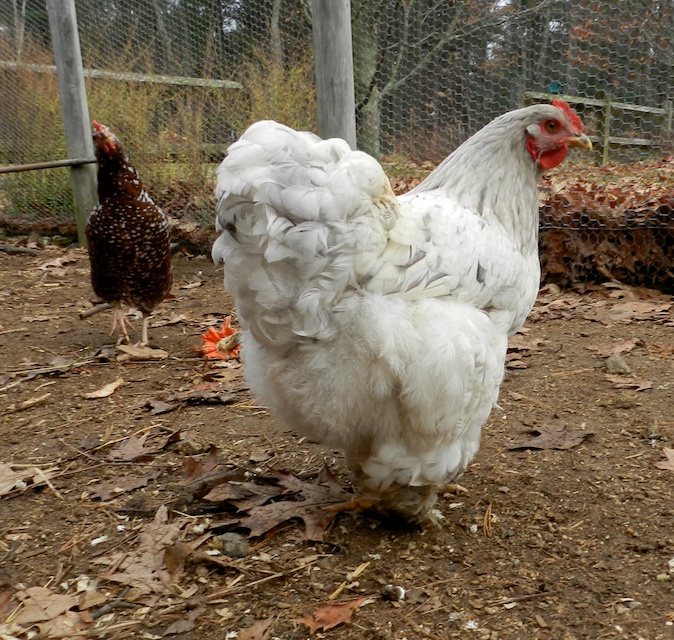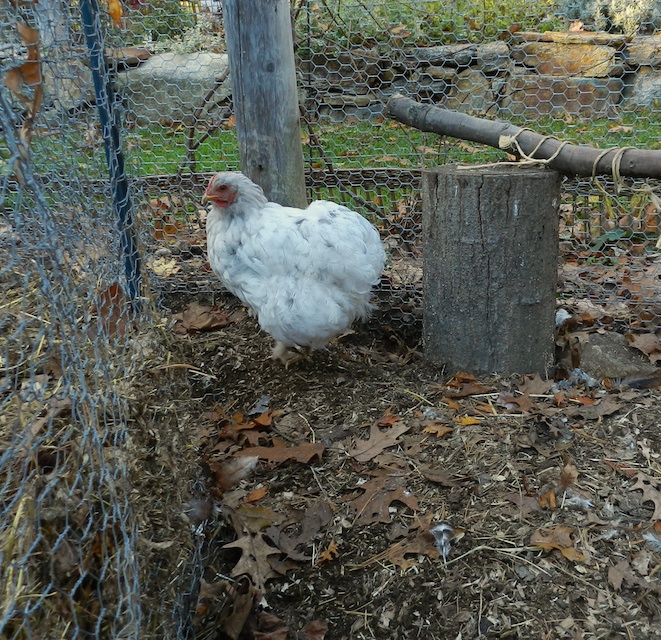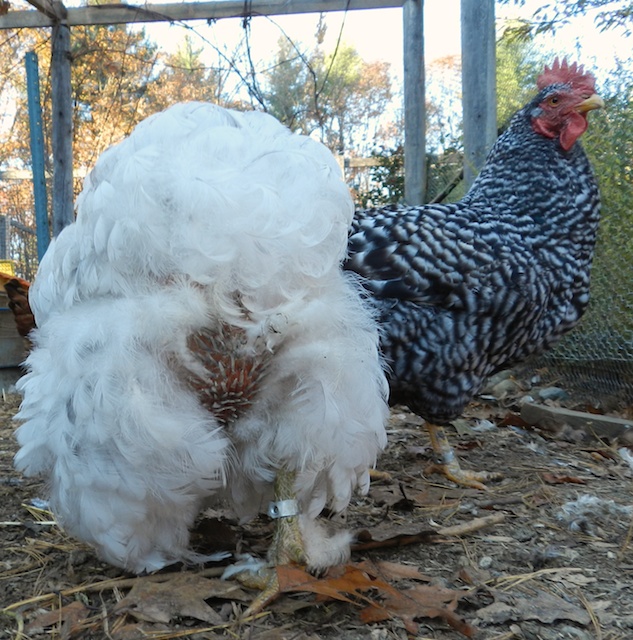Pearl, my beautiful splash Cochin, usually looks like a feather duster that would have been used in a Victorian mansion.
Cochins are fluffy because they have many more soft feathers than other breeds. Also, they lack hard, shiny outer feathers. But, each year, just like all other chickens, Cochins drop their thousands of feathers and grow in new ones. This should happen just once. But, for some reason, Pearl went through an early, partial molt in July. I wasn’t surprised, because the worst layers molt first, and Pearl rarely lays. After the molt, she went broody for weeks. Then, mid-October she roused herself from her broody stupor and went into a second molt.
Pearl has so many feathers that at first, you might not notice that she is molting. From a distance, Pearl appears to be as lovely as ever.
But, look closely, and you’ll see that her coat appears looser. New feathers are emerging on the wings. And her bottom looks like this. (It’s obvious when the wind is blowing!) No wonder normally friendly hens don’t want to be picked up during the molt. Would you want to be handled with quills sticking out of your bottom?
Cochins have feathered feet, and even those feathers fall out and new ones grow in. Looking at her legs, I became worried, as the scales are sticking out and not smooth like they should be. Was this scaly leg mite?
No, it was just the new feather shafts pushing their way out. It does look uncomfortable, doesn’t it?
A few more weeks and Pearl will be fully dressed again. Have patience, Pearl!
PS Because I know you’ll ask – I don’t do much different for my molting hens. They appreciate dust baths, so I make sure that they free-range and that their dust bathing bin in the coop is full and clean. I’m careful not to feed bread and pasta as treats, but do toss them a handful of my dog’s expensive fish kibble every few days, because the chickens need quality protein in order to regenerate their feathers. (But, overdoing the protein can cause problems, so I use restraint.) I recently got some chopped alfalfa, which is very good for them. Older hens can have a bit more trouble getting through the molt, so the ancient chickens in the Little Barn are getting a handful of shelled sunflower seeds (not much, a tablespoon per bird!) per day. But, really, all that they need is time and patience.





Poor Pearl – molting seems to be an uncomfortable and embarrassing process for many chickens.
I chuckled when I saw the hen in the background of the first photo: Is that Florence or Agatha tiltng her head to one side, wondering what you are doing?
I’ve always thought her beautiful. Love the lavender color or light gray. It’s post like these that help so much. I spend a lot of time with my chickens and when one is acting different, I start to worry. Somewhere in my memory I’ll remember something you said in one of these posts and then it makes perfect sense. I’ll remember not to hold them much when they are molting. Thanks for helping. Hope all is going well with Tonka.
Tonka has to pass a vet exam on Monday. I’ll ride him one more time next week. If all goes well, and he’s still the right horse for me, he comes home on Dec. 2.
OUCH! That does look uncomfortable!
Pearl started molting right after the Big Barn girls had that respiratory illness, right? That must have just messed up her timing this year. She is a very pretty hen.
Pearl is a pretty hen, it’s too bad she hasn’t figured out your fingers could gentle rub off those keratin sheaths, but as I said before it seems few chickens can stand it. Other than your Snowball, and one rooster I have seen. I guess its few chickens or cats who figure out when you are trying to help them either with medicene or other issues and will just sit there and let you do it.
I also know you said you won’t get another cochin, and I know frizzles cochins needs so much more care, but do you think maybe since their feathers are curly that their feet feathers maybe won’t get so dirty and then you just have to be careful with their curly weathers in cold and wet weather. So Terry do you think you might ever get a frizzle be a cochin, polish, or other breed if they develop one ?
For many years, I had a Parrotlet, the smallest breed of parrot. Chirps (I know, I know) was a Pacific Blue and really beautiful, and although slightly smaller than a typical parakeet, he talked quite a bit in a thin, tinny voice. He was hilarious. When he was molting he would ‘beg’ me to very gently scratch his neck and base of his tail to remove the hard keratin sheaths covering his new feathers, all the while muttering ever so quietly, “careful…careful…careful…” I miss the little guy.
Sweet story, Tracy! When I was a preteen we had several parrots, given to us by a friend who no longer wanted them – ours had much more than “tinny” voices!
Oh that is beyond adorable Tracy and Terry. Though with as much as domesitication has changed chickens though probably not as much as other animals, that that allopreening might have come up. Oh well with other domestic animals, we have probably made them dumber than their wild grey and red junglefowl ancestors. My story isn’t as cute, it’s just my siamese cat Toby figured out that his insulin shots made him feel so much better and without any training or treats. For the last two years of his short nine year life he would come to my mother, me or our babysitting vet tech without any prompting twice a day, sit down and calmly allowed us to give him his shots. I have had four other cats since him, two of which are still alive, none of them ever shown that connection. Though my sweet Lilith didn’t fight me as much as other cats when she had a serious liver infection and I had give her liquid meds several times a day. Couldn’t put them in food and she was very patient though fussed but still I think is towards her mellow personality than anything else. Jesse is while a sweet cat in everything else is a hellion when it comes to nail cutting and even being brushed out !!! No treats or training will entice him for any reason. He is the first cat ever that hates to be gentlely brushed or combed, most cats just accept it as part of us mutually groomming them.
Glad to hear also that you have parrots Terry, haven’t had much experince with them other than a friend’s rescue quaker parrot. Quakers though do seem like a good parrot breeds and I think out of all parrots will probably be the definite third domesicated breed after parakeets and cockatiels.